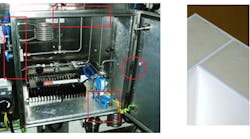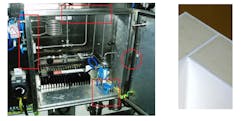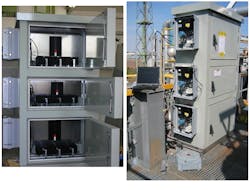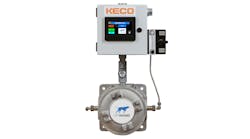Protective enclosures are important elements of virtually all process analyzers. Some current trends in analyzers are making the design of such enclosures more critical. This places a focus on the construction materials and techniques used.
Smaller analyzers
There have been huge advances in analyzer miniaturization in recent years, from more compact sensing technologies, to modular surface-mounting substrates for building sensing and stream switching systems. This has led to many more analyzers being sited online within a plant. There are often challenges in doing this, as installation space has to be found in crowded environments, operator access can be difficult, and the instruments themselves are often extremely sensitive. An associated trend, is to pack more smaller-sized analyzers into the traditional styles of larger shelters.
Maintaining a steady sample temperature and stable operating environment for the analyzer is vital in order to produce reliable results, and the thermal performance of protective housings is important for either application scenario.
A high degree of insulation means a more stable and easily controllable internal environment for smaller cabinets - plus lower energy consumption of course. It also means less interference with the temperature regulation of neighboring equipment - which is useful in cluttered shelters where numerous equipment cases are often mounted inside a common larger housing. These individual boxes can have quite different temperature regulation requirements, to the extent that some might need cooling (e.g. computer equipment), while others need heating (e.g. a gas chromatograph oven, or a sample conditioning system). If care is not taken over layout and positioning, this can result in energy-inefficient 'gas guzzler' shelters.
In these environments, choice of enclosure materials and construction is key. Sheet metalwork is still the most common material used. Achieving a high degree of enclosure insulation with metal can be difficult. Metal is inherently conductive and even if good insulation is applied there are often points in the enclosure that are not covered. Insulation performance is also worsened by 'thermal short cuts' (from exterior to interior) caused by the necessary connection holes - for tubing, cabling, etc - as well as from construction fixings and components that hold the enclosure together (Figure 1). These short cuts usually account for over 75% of total losses.
Heat losses from metal enclosures (left), from shortcomings in insulation coverage (circle), and connections to the exterior (oblongs), can be problematic. Intertec's sandwich GRP constructions (right) enclosing foam cores improve insulation levels dramatically.
In contrast, GRP (glass reinforced polyester) has a thermal conductivity that is some three orders of magnitude lower than metal. In Intertec's GRP enclosures, insulation is typically applied to this superior material by using a 'sandwich' construction of GRP sheets enclosing a core of polyurethane foam. As the composite construction is bonded together, insulation performance is near perfect. Although most enclosures have heaters for temperature regulation or freeze protection, the performance of insulation can be even more important if the analyzer is in an environment requiring cooling. This is because the power requirements of HVAC supplies can add a great deal of cost and complexity to installations in remote locations, and in hazardous environments.
Another aspect of the trend to place analyzers directly online, is the need for enclosure compactness and lightness, and even shape optimization. GRP is around 25% of the weight of steel, making it possible to mount analyzers directly onto piping, or onto structures such as process columns. The construction techniques for GRP cabinets also make it simple to create special shapes (Figure 2).
A novel Intertec GRP cabinet for an online analyzer located on a 25m-high process column. Highly insulated walls thermally separate each analyzer. Low weight was important. A custom vertical shape minimized footprint. One of the analyzers is also duplicated, so that the stream can be switched and analysis remains operational even during maintenance.
Exterior protection
Another example of a general trend affecting enclosure design for analyzer applications is the increasing numbers of plants being built in harsh environments, such as Arctic, desert and offshore conditions. Traditional metal enclosures, even stainless steel types, can be exposed to accelerated corrosion mechanisms here. By contrast, GRP does not rust or degrade in any meaningful way, allowing maintenance-free lifecycles of 30 years or more. Another benefit is the use of protective surface gel-coats, which are around an order of magnitude thicker than the protective paint coatings sprayed onto metal. Intertec has documented examples of GRP enclosures that have survived for 40 years in petrochemical environments - with local atmospheres containing corrosive chemicals such as sulphuric acid.
Offshore applications can be especially difficult. The 'floating LNG plant' Prelude provides an interesting example. Analyzer cabinet requirements were extremely stringent. Cabinets had to offer a high degree of resistance to corrosion being caused by the saline environment and the presence of sour or acid gas. The ability to cool equipment without using explosion-proof air conditioning, which incurs high capital and operating costs, was also desirable. These challenges were met by GRP's intrinsic resistance to the corrosive effects of most oil and gas media. Sandwich GRP constructions optimized insulation and made it feasible to employ semi-passive cooling (the vessel is near the Equator). Cabinets are fitted with a heat exchanger connected to cold water system with seawater obtained via a 150m pipe. www.intertec.info
For more information please contact:
Intertec Instrumentation Ltd, 255 Henry Drive, Sarnia, Ontario N7T 7H5, Canada.
Tel: +1 888 875 8756; [email protected]
Intertec Instrumentation Inc., 11116 West Little York, Building 1, Houston, Texas 77041, USA.
Tel: +1 832 243 0790; [email protected]






